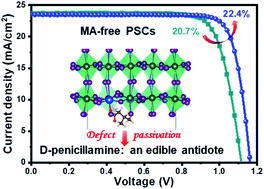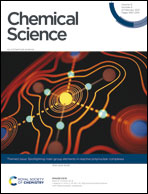Defect mitigation using d-penicillamine for efficient methylammonium-free perovskite solar cells with high operational stability†
Abstract
Trap-dominated non-radiative charge recombination is one of the key factors that limit the performance of perovskite solar cells (PSCs), which was widely studied in methylammonium (MA) containing PSCs. However, there is a need to elucidate the defect chemistry of thermally stable, MA-free, cesium/formamidinium (Cs/FA)-based perovskites. Herein, we show that D-penicillamine (PA), an edible antidote for treating heavy metal ions, not only effectively passivates the iodine vacancies (Pb2+ defects) through coordination with the –SH and –COOH groups in PA, but also finely tunes the crystallinity of Cs/FA-based perovskite film. Benefiting from these merits, a reduction of non-radiative recombination and an increase in photoluminescence lifetime have been achieved. As a result, the champion MA-free device exhibits an impressive power conversion efficiency (PCE) of 22.4%, an open-circuit voltage of 1.163 V, a notable fill factor of 82%, and excellent long-term operational stability. Moreover, the defect passivation strategy can be further extended to a mini module (substrate: 4 × 4 cm2, active area: 7.2 cm2) as well as a wide-bandgap (∼1.73 eV) Cs/FA perovskite system by delivering PCEs of 16.3% and 20.2%, respectively, demonstrating its universality in defect passivation for efficient PSCs.

- This article is part of the themed collection: 2021 Chemical Science HOT Article Collection


 Please wait while we load your content...
Please wait while we load your content...